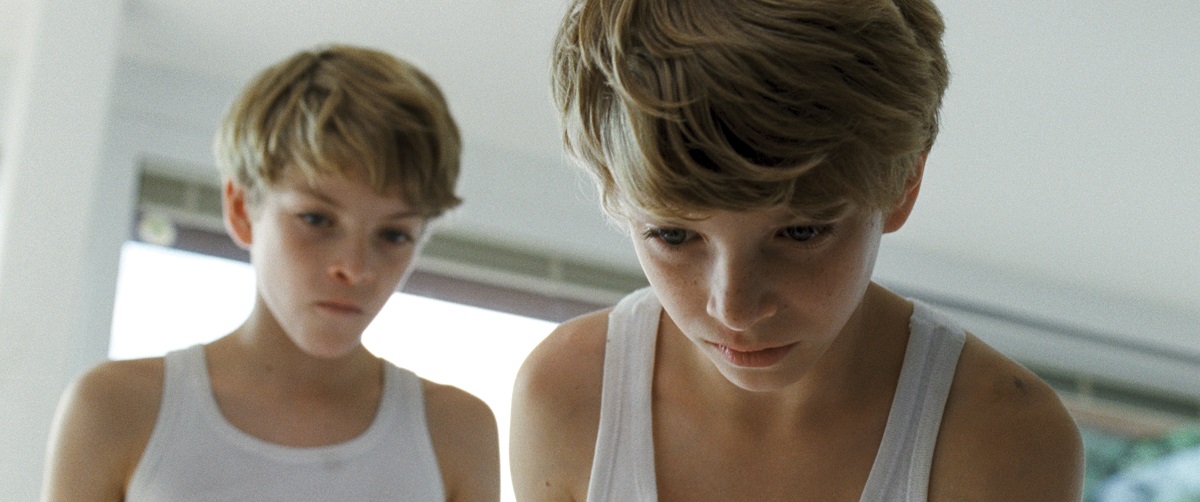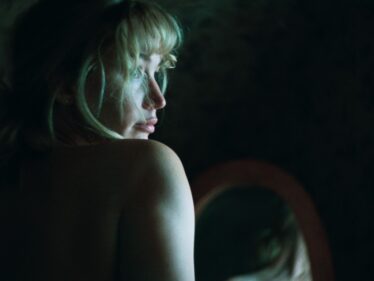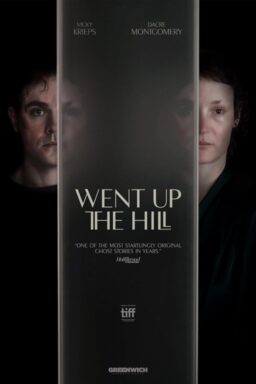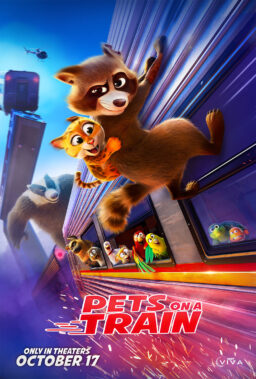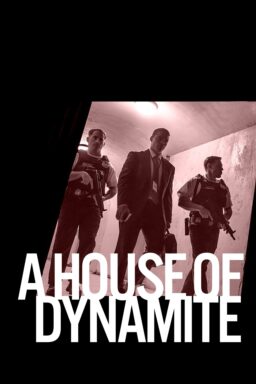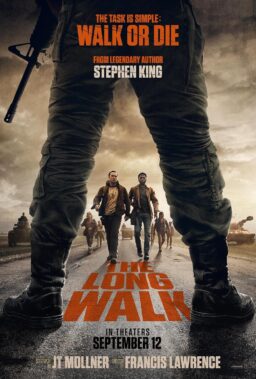“Goodnight Mommy” is a violent, terrifying, and gorgeous-looking arthouse horror film from Austrian co-directors and co-writers Severin Fiala and Veronika Franz. Shot on 35mm by celebrated cinematographer Martin Gschlacht, “Goodnight Mommy” has an icy focus and nightmarish atmosphere, featuring an unbearable build to an excruciatingly upsetting final act. Identical twins Elias and Lukas Schwarz join the ranks of other “creepy twins” in cinema, and Susanne Wuest, as their mother, is a cipher of strangeness, her head wrapped entirely in bandages. Returning home after getting a mysterious operation, the mother lies in bed for most of the day, and the twin boys become convinced that she is not really their mother. “Goodnight Mommy” was produced by the great Ulrich Seidl (married to Franz, who is also a longtime film journalist), and both Franz and Fiala are in love with cinema and its potential to sweep audiences away, to move us or shatter us.
I sat down with the directing/writing duo in New York recently to discuss the extremely enjoyable (and extremely extreme) “Goodnight Mommy.”
How do you work together as a team in writing the script?
Veronika Franz: The basic idea was that a mother comes home and the children don’t recognize her or doubt that she is their mother. There was a German docu-soap series which inspired us, and it’s about women getting facial operations, and separated from their families for months as they get their teeth done, their hair done, and after months they appear totally different in front of their families. They stage this magic moment on the red carpet and there is the family waiting for her.
Do the children cry?
VF: Yes. It’s supposed to be a happy moment because the mother is so beautiful – in the standards of society – they look young again, they have good teeth now, but if you look closely at the children, you always can see a massive irritation because …
That’s not their Mom.
VF: Yes, that’s not Mom. And there was one moment in the series when a child said the words, “It’s not Mom. It’s not Mom.”
It’s traumatizing.
VF: That was the start. We write together. We sit physically together. We develop ideas and write them down. We talk things over. We have the same ideas that we have developed over 20 years by watching films and discussing them. We have developed a very similar idea of what we like.
Severin Fiala: We trust each other. If I have a feeling a scene is good or bad, I don’t have to talk to her [about it] only because I know she feels the same.
VF: If I have an idea and I tell him the idea, and he said, “It’s bullshit” I would drop it because I know it’s not good. It’s not about vanity or ego or being right. It’s about writing a really suspenseful film together.
SF: People say, “It must be really slow to work together, because you have to decide on everything together” but we think it’s faster, actually. If you imagine writing alone, it’s a very lonely thing. If I write alone and I have an idea I’m not sure about, it may take a week to decide to write it down or to drop it.
VF: We have known each other for 20 years. I used Severin as a babysitter and I would pay him by renting him video cassettes because he was so into films. We watched many different films together.

The film is so interesting about identity. Every scene has some element of mirroring in it, the pictures on the wall mirroring the dolls in the fireplace, and so on. She is masked. The little boys put on masks at one point, but also, they are identical twins, so they look exactly the same anyway. Aside from the fact that there is a long history of scary identical twins in films, I wondered your thoughts on how all of those things work together.
SF: The first idea was the mother coming home, and then we came up with the idea of two boys – her sons – and then we came up with the idea that the brothers should look the same, because the film is, like you said, about identity, and the masks we wear, and what’s underneath beautiful surfaces. Like cockroaches crawling underneath. We are interested in what makes you become you.
VF: We think that you have several identities. You are different depending on different circumstances. That’s what we tried to play through with all of those images.
SF: We didn’t want to make a film that you can watch from a distance. In the first place, we wanted it to be a thrilling film, and once the thrill ride is over and the film is over, then you can see all of these themes in the film, but only in retrospect. It’s kind of why we like cinema. It has the power to really get to you.
How did you find those boys, Elias and Lukas Schwarz? I am sure everyone is asking you that.
VF: Part of why they are so natural is [because of] the working method we did with them. We played with them a lot. We worked with them chronologically, so we revealed to them day by day the story.
SF: It was easy to find them, actually. It seems to be really difficult but it’s so specific: we would call schools and they would know if there were twins that age. We had a lot of twin pairs to look at. 130 pairs of Austrian twins.
VF: The casting was very fun because we played games with them. The original film title was “Ich seh Ich she” – “I Spy“, like the game: “I Spy with my little eye”. It was a game we had in the film, but we cut it out. We used this game in the casting, and twins cannot play this game actually, because they always know [the answer]. “I see something which is pink” – and the other twin would know it immediately. And the game with scissors …
Rock Paper Scissors.
VF: Yes. Twins can’t play it because both twins always chose the same one! It was quite an interesting casting situation. We were looking for beautiful children, fragile children you could identify with in the beginning, but they also had to have a secret to them.
SF: You would have to feel an abyss, something hidden behind the surface. That is what we were looking for with the house, with all of the characters, that you could feel something behind the surface.
VF: We did casting rounds where we tied the actress on a chair and told the twins – in the end, we had three pairs – we told them “She kidnapped your mom, you have to find out where your Mom is.”
SF: [We told them] “Do whatever you want.” It was difficult because children do not want to … hurt adults.
VF: [The twins we ended up casting] we decided were the most courageous ones. One picked up a pencil and poked her arm with it!
SF: The most important thing in working with children is to keep them interested in the story, and in the whole process, because if we had told them how the whole story would end on the first day, they wouldn’t be interested anymore. Apart from that, it was really easy to work with them because children trust you, if you’re an adult. If you tell children, “Do it this way,” they will really try to do it that way. That’s not always the case with [adult] actors because they have their own ideas and of course they will tell you, “Okay, I’ll do it the way you want me to” and they’ll do it but if it goes wrong you never know where the mistake happened. But with children it’s really direct and straightforward in a way.
VF: If they fail, we knew —
SF: It’s our fault.
VF: It’s our fault. We told them something wrong, because they really tried to do what we asked them to do.
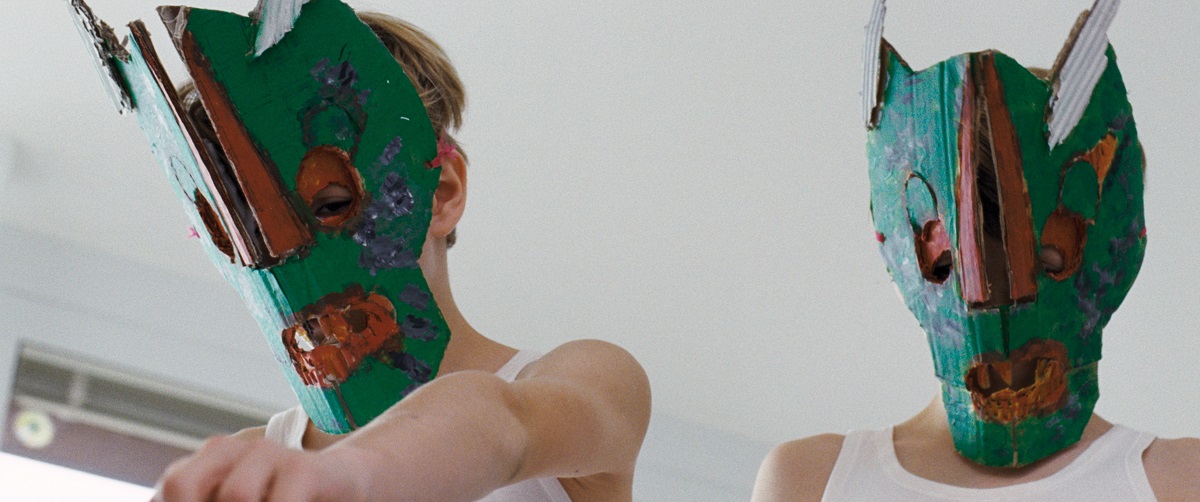
I was really taken by the fact of how little dialogue they have between each other. Their planning goes on silently.
VF: They understand each other without any words.
SF: It was also about us wanting to make a nearly-silent film, a film in which no one talks, a film that tells its story in pictures. That’s what cinema can do, and should do. We only used dialogue when we couldn’t think of any solution to lose it.
When the Red Cross couple shows up, they seem like they are from another planet. They talk like normal people and I had forgotten there were normal people left in the world.
SF: Those are friends of ours. They are really Red Cross workers!
VF: Could you sense that?
I assumed that they were. They seemed totally real.
VF: That’s good!
I saw in the credits that you said it was “gloriously shot on 35 mm.” Could you talk a little bit about shooting on film?
SF: There are two reasons why we desperately wanted to shoot it on 35 mm and why we fought for it. First, because it looks better aesthetically, for us. It feels more alive, and has more secret to it than digital.
VF: We made a lot of tests because the cinematographer [Martin Gschlacht] at first wanted us to shoot digitally.
SF: Everyone advises you to shoot digitally nowadays. They advised us to shoot digitally because it’s our first film, there are children in it who didn’t learn dialogue, there was lots of improvisation, so they said do it digitally. But I think film looks better, we were sure of that. Apart from the aesthetic part, it’s also a completely different kind of work if you shoot on film. If you shoot digitally, people advise you to just press the button, film the children, and something good will come up. Maybe you film for half an hour, and you use a little part of it. The bad part of it is that all of the team is like … [pretends to fall asleep] There’s no concentration at all. If you shoot on film, it costs a lot of money and it has to happen right now and everyone is on the edge, and they want to do their best to make it possible that the good stuff happens right now. It’s a really different kind of concentration.

This is kind of a two-part question: The house location was such a huge part of the film. Could you talk a little bit about the house, and could you also talk about Martin Gschlacht, the cinematographer, and how you all worked together to create the look of the film?
VF: Of course the house should describe the mother, as we follow the story in the first half, and it comes out of the perspective of the children. It was only how the children see her. The house was the mother and nature was the world of the children. We wanted to have the house very dark, like a prison, where she imprisons herself and also the children, and after the second half, we pulled the blinds up and let the light in, and also the camera changed. In the beginning it’s very static and in the last third, it’s hand-held camera.
SF: Martin Gschlacht has done over 30 films, and we were afraid to work with him at first because we thought – It’s his 4th film this year, and we are first-time directors – but it was so great, because he was really really interested in how WE would like to do a film.
He wanted to help bring out your vision.
VF: Yes. And that is very rare. He was an artistic collaborator.
SF: And he hates horror films.
VF: Yes, he hates horror films! There were three times he said, “That is the most terrible thing I’ve ever shot.” The cockroaches, he hated the cockroaches, and also the bones in the graveyard. He said it was the most terrible shooting day he had ever had.
SF: He couldn’t even look at the cockroaches. The only time he could look at them was through the camera.
VF: So the film pushed him a little bit! And I think in the end he really loved shooting on film. He was skeptical in the beginning but then he really loved it. He re-fell in love with film. We are planning our next film and we desperately want to shoot on film again.
SF: We have to shoot on film because it’s a film about film. It’s about a projectionist, who was also the last executioner of Vienna. He was a part-time executioner and at the other time of the day he was a cinema projectionist.
This is a true story?
SF: This is a true story.
I am already excited for it.
VF: The problem with film is that if you want to do it in black and white – black and white film is not developed anymore. That’s really a pity because if you think in terms of painting: you can still do oil paintings, you can choose whatever material you want, whatever colors you want, but you can’t with film. It’s a big loss, I think.
You both have discussed how you love what you call “physical cinema.”
VF: I want to be attacked in cinema. In Austria we have a very long theatre tradition. You sit there in the theatre, you lean back, and you think it all through. But we like cinema that attacks you, that does something to your body. We even had two people who fainted at screenings! Severin had always dreamt of something like this because once he was in a screening of a John Carpenter film and there was a man behind him who fainted.
SF: We had to drag him out. I had always dreamed of something like that.
VF: It goes back to the beginning of cinema. I am sure you know the story about the Lumière brothers, the first screenings where the train is coming and entering the station, and the people in the audience ducked. That’s something that only film can do.

